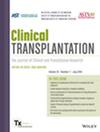Exercise Performance in Transplant Recipients of Hearts From Donation After Circulatory Death and Donation After Brain Death
Abstract
Background
Heart transplantation (HT) following donation after circulatory death (DCD) has grown substantially in recent years. However, the effects of functional ischemic injury during procurement on exercise capacity remain unknown. We compared exercise performance parameters between DCD and donation after brain death (DBD) recipients.
Methods
We conducted a single-center, retrospective, case–control study of adults with isolated HT between January 2022 and April 2024 and completed a treadmill cardiopulmonary exercise test (CPET) post-transplant. DCD-HT recipients (cases) were matched to DBD-HT recipients (controls) based on major demographics and CPET timing. The primary outcome was peak oxygen consumption (pVO2). Secondary outcomes included additional exercise capacity parameters and echocardiographic indices at peak exercise.
Results
Cases (DCD-HT: n = 10, 20% female) and controls (DBD-HT: n = 10, 20% female) had similar baseline characteristics. Total ischemic time was longer in the DCD group (6.9 [interquartile range (IQR): 6.4–7.1] vs. 4.6 [IQR: 3.94.8] h; p = 0.002). Time from HT to CPET did not differ. DCD and DBD-HT recipients had similar pVO2 (17.1 [IQR: 15.2–19.7] vs. 19.7 [IQR: 13.3–21.2] mL/kg/min; p = 0.545). Respiratory exchange ratio (RER) was slightly lower in the DCD group (1.1 [IQR: 1.0–1.2] vs. 1.2 [IQR: 1.21.3]; p = 0.031). Ventilatory efficiency (VE/VCO2) at anaerobic threshold, left ventricular ejection fraction, and E/e′ at peak exercise were comparable between groups.
Conclusion
DCD and DBD heart transplant recipients demonstrate similar exercise performance. Overall, exercise capacity remains limited after HT, highlighting the need for further studies to identify underlying mechanisms and potential therapeutic interventions.

 求助内容:
求助内容: 应助结果提醒方式:
应助结果提醒方式:


